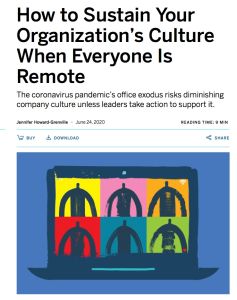
Article
How to Sustain Your Organization’s Culture When Everyone Is Remote
The coronavirus pandemic’s office exodus risks diminishing company culture unless leaders take action to support it.
Recommendation
Cambridge University Professor Jennifer Howard-Grenville explains in the MIT Sloan Management Review that corporate culture is much more than the physical elements of an office. With more people working remotely, companies must focus on the core elements of their culture in order to sustain it. While video meetings give employees less of an ability to emulate your company culture, managers can find ways to support and expand culture with remote workers. This article provides a useful backgrounder for managers who lead remote teams.
Summary
About the Author
Jennifer Howard-Grenville, a professor at the University of Cambridge’s business school, specializes in organizational studies and change.






















Comment on this summary